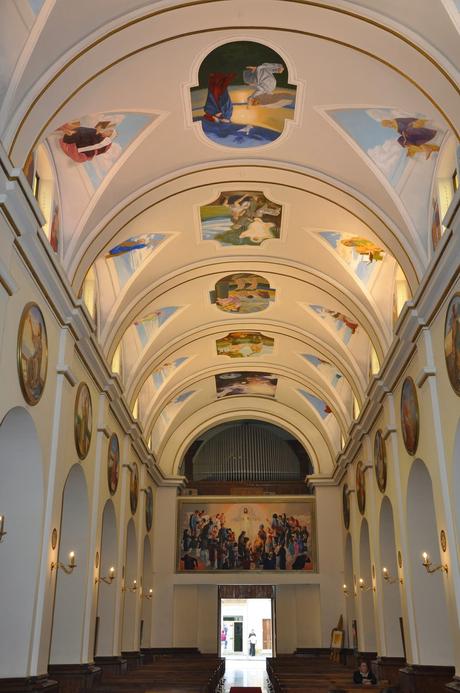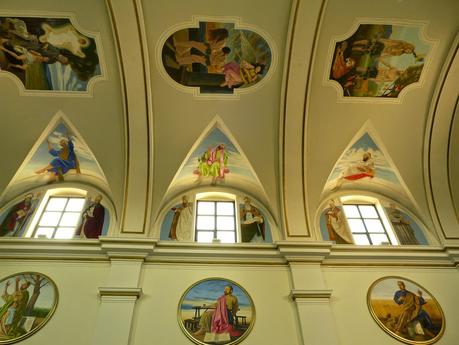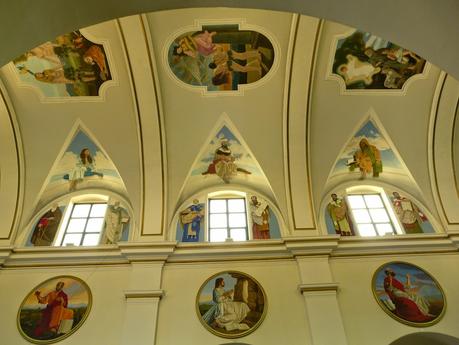
Rodolfo Papa, Intera decorazione navata centrale Cattedrale di Bojano (CB) 2000-2011
Every art is in a certain way “religious”, but is every art not “sacred”?For sure every form of art can be understood in its deep meaning as a “religious” answer to the basic questions of life. But of course religious is not sacred, least of all Christian sacred. Without doubt a poem by Giacomo Leopardi or by Georg Trakl like a novel by Robert Musil or Franz Kafka have a religious content, they express the search for an answer to the human and inescapable questions of life. Not only poems and literature, but also every artistic form has inside the capability to express a religious feeling. In sculpture, in painting, also in the architecture, and also dancing, theatre, photography, until every new artistic discipline invented in last decades, in all of them can be expressed in some way the humanum, that is what concerns intimately the human being, and it is so also in the abstract art. Indeed we can say that all the arts lead to a tension, which can be certainly defined as “religious”. In the contemporary artistic expression prevails the expression of the subjective and individualistic element. The religiousness of the artistic work is strictly connected to the expression of the subjectivity, of the “ego”. In particular the prevailing dimension of the abstract painting is the subjective expression of the feeling, emotions, from the thunderous thud in the darkness of the heart to the light breeze of calm, the bright joy of a jumping heart or of the insanity delirium. It is that the condition of a subjective expression of feelings to insert de iure the abstract painting among the possible variations of the artistic religious, but it is that condition that shows it as unable to express the Christian sacred. Indeed the Christian art exists to proclaim the truths of the Gospel, to praise the Lord, to serve the sacred liturgy. These goals cannot be spread by abstract forms, they want – as the long tradition of Christian art shows – a beautiful, universal, figurative, narrative art. Indeed in the arts cannot be contradictions or dissonance between expressive forms and expressed content.
Ogni arte è in un certo modo “religiosa”, ma non ogni arte è “sacra”?Di fatto ogni forma d’arte può essere intesa nel suo senso profondo come una risposta “religiosa” alle domande fondamentali della vita. Ma il religioso non è certamente il sacro, né tantomeno il sacro cristiano. Senza dubbio, una poesia di Giacomo Leopardi o di Georg Trakl come un romanzo di Robert Musil o di Franz Kafka possiedono un contenuto religioso, esprimono la ricerca di una risposta ai quesiti umanissimi ed ineludibili del vivere. Non solo la poesia e la letteratura, ma ogni forma artistica ha in sé la possibilità di esprimere un sentimento religioso. Nella scultura, nella pittura, come anche nell’architettura, o ancora nella danza, nel teatro, nella fotografia, fino ad ogni nuova disciplina artistica inventata negli ultimi decenni, in tutte può essere espresso in qualche modo l’humanum, ciò che intimamente riguarda l’essere umano, e così anche nelle opere di arte astratta. Anzi possiamo dire che tutte le arti siano riconducibili ad una tensione che può senz’altro essere definita “religiosa”.
Nell’espressione artistica contemporanea, prevale l’espressione dell’elemento soggettivo ed individualistico. La religiosità dell’opera artistica è intimamente connessa alla espressione della soggettività, dell’“io”. In particolare, la dimensione prevalente della pittura astratta è l’espressione soggettiva del sentimento, dei moti dell’anima, del tonfo assordante nel buio del cuore o della brezza leggera della serenità, della gioia squillante di un cuore che saltella o del delirio della follia. È proprio questa condizione di espressione soggettiva dei sentimenti ad inserire di diritto la pittura astratta tra le possibili variazioni del religioso artistico, ma proprio questa condizione di fatto la palesa anche come incapace di esprimere il sacro cristiano. L’arte sacra cristiana, infatti, esiste per proclamare le verità del Vangelo, per lodare il Signore, per servire la sacra liturgia. Queste finalità non possono essere veicolate dalle forme astratte, ma richiedono – come tutta la lunga tradizione dell’arte cristiana mostra – un’arte bella, universale, figurativa e narrativa. Infatti, nelle arti non può esserci contraddizione o dissonanza tra le forme espressive e il contenuto espresso.






